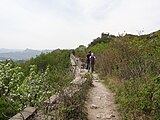
Great Wall of China
The Great Wall of China (traditional Chinese: 萬里長城; simplified Chinese: 万里长城; pinyin: Wànlǐ Chángchéng, literally "ten thousand li long wall") is a series of fortifications that were built across the historical northern borders of ancient Chinese states and Imperial China as protection against various nomadic groups from the Eurasian Steppe. Several walls were built from as early as the 7th century BC,[4] with selective stretches later joined by Qin Shi Huang (220–206 BC), the first emperor of China. Little of the Qin wall remains.[5] Later on, many successive dynasties built and maintained multiple stretches of border walls. The best-known sections of the wall were built by the Ming dynasty (1368–1644).
"Great Wall" redirects here. For other uses, see Great Wall (disambiguation).Great Wall of China
Fortification
The Great Wall
Cultural: i, ii, iii, iv, vi
1987 (11th Session)
2,151.55 ha
4,800.8 ha
"The Long Wall"
Chángchéng
Chángchéng
Ch'ang2-ch'eng2
zan平 zen平
Cheung4 sing4
Coeng4sing4
Tn̂g-siâⁿ
Tn̂g-siânn
"The 10,000-li Long Wall"
Wànlǐ Chángchéng
Wànlǐ Chángchéng
Vae去-li上 zan平-zen平
Maan6lei5 Cheung4sing4
Maan6-lei5 coeng4-sing4
Bān-lí tn̂g-siânn
Apart from defense, other purposes of the Great Wall have included border controls, allowing the imposition of duties on goods transported along the Silk Road, regulation or encouragement of trade and the control of immigration and emigration.[6] Furthermore, the defensive characteristics of the Great Wall were enhanced by the construction of watchtowers, troop barracks, garrison stations, signaling capabilities through the means of smoke or fire, and the fact that the path of the Great Wall also served as a transportation corridor.
The frontier walls built by different dynasties have multiple courses. Collectively, they stretch from Liaodong in the east to Lop Lake in the west, from the present-day Sino–Russian border in the north to Tao River (Taohe) in the south; along an arc that roughly delineates the edge of the Mongolian steppe; spanning 21,196.18 km (13,170.70 mi) in total.[7][3] Today, the defensive system of the Great Wall is generally recognized as one of the most impressive architectural feats in history.[8]
Characteristics
Before the use of bricks, the Great Wall was mainly built from rammed earth, stones, and wood. During the Ming, however, bricks were heavily used in many areas of the wall, as were materials such as tiles, lime, and stone. The size and weight of the bricks made them easier to work with than earth and stone, so construction quickened. Additionally, bricks could bear more weight and endure better than rammed earth. Stone can hold under its own weight better than brick, but is more difficult to use. Consequently, stones cut into rectangular shapes were used for the foundation, inner and outer brims, and gateways of the wall. Battlements line the uppermost portion of the vast majority of the wall, with defensive gaps a little over 30 cm (12 in) tall, and about 23 cm (9.1 in) wide. From the parapets, guards could survey the surrounding land.[59]
Sticky rice mortar, consisting of sticky rice soup mixed with slaked lime, was extensively used to hold bricks together;[60][61] no human bones or body parts were ever incorporated into the mortar or any part of the wall, contrary to what a legend states.[62][63] Communication between the army units along the length of the Great Wall, including the ability to call reinforcements and warn garrisons of enemy movements, was of high importance. Signal towers were built upon hill tops or other high points along the wall for their visibility. Wooden gates could be used as a trap against those going through. Barracks, stables, and armories were built near the wall's inner surface.[59]

















